All-Dielectric Color Filter with Ultra-Narrowed Linewidth
Abstract
1. Introduction
2. Simulation Models
3. Results and Discussion
3.1. Optimization of the FP Cavity
3.2. Optimization of the Band-Pass Filter
3.3. Evaluation of the Device’s Performance
4. Conclusions
Author Contributions
Funding
Conflicts of Interest
References
- Wang, S.-W.; Xia, C.; Chen, X.; Lu, W. Concept of a high-resolution miniature spectrometer using an integrated filter array. Opt. Lett. 2007, 32, 3. [Google Scholar] [CrossRef]
- Liu, J.N.; Schulmerich, M.V.; Bhargava, R.; Cunningham, B.T. Sculpting narrowband Fano resonances inherent in the large-area mid-infrared photonic crystal microresonators for spectroscopic imaging. Opt. Express 2014, 22, 18142–18158. [Google Scholar] [CrossRef] [PubMed]
- Sabnis, R.W. Color filter technology for liquid crystal displays. Displays 1999, 20, 11. [Google Scholar] [CrossRef]
- Xu, T.; Wu, Y.-K.; Luo, X.; Guo, L.J. Plasmonic nanoresonators for high-resolution colour filtering and spectral imaging. Nat. Commun. 2010, 1, 5. [Google Scholar] [CrossRef]
- Yu, Y.; Wen, L.; Song, S.; Chen, Q. Transmissive/Reflective Structural Color Filters: Theory and Applications. J. Nanomater. 2014, 2014, 1–17. [Google Scholar] [CrossRef]
- Fleischman, D.; Fountaine, K.T.; Bukowsky, C.R.; Tagliabue, G.; Sweatlock, L.A.; Atwater, H.A. High Spectral Resolution Plasmonic Color Filters with Subwavelength Dimensions. ACS Photonics 2019, 6, 7. [Google Scholar] [CrossRef]
- Ogawa, S.; Kimata, M. Metal-Insulator-Metal-Based Plasmonic Metamaterial Absorbers at Visible and Infrared Wavelengths: A Review. Materials 2018, 11, 458. [Google Scholar] [CrossRef] [PubMed]
- Schaffernak, G.; Krug, M.K.; Belitsch, M.; Gašparić, M.; Ditlbacher, H.; Hohenester, U.; Krenn, J.R.; Hohenau, A. Plasmonic Dispersion Relations and Intensity Enhancement of Metal−Insulator−Metal Nanodisks. ACS Photonics 2018, 5, 4823–4827. [Google Scholar] [CrossRef]
- Vo-Dinh, T.; Lakowicz, J.R.; Li, E.; Chong, X.; Ren, F.; Wang, A.X. Plasmonic filter array for on-chip near-infrared spectroscopy. Proceeding of the SPIE Plasmonics in Biology and Medicine XIII, San Francisco, CA, USA, 13 February 2016; Volume 9724, p. 7. [Google Scholar] [CrossRef]
- Girard-Desprolet, R.; Boutami, S.; Lhostis, S.; Vitrant, G. Angular and polarization properties of cross-holes nanostructured metallic filters. Opt. Express 2013, 21, 13. [Google Scholar] [CrossRef]
- Si, G.; Zhao, Y.; Liu, H.; Teo, S.; Zhang, M.; Jun Huang, T.; Danner, A.J.; Teng, J. Annular aperture array based color filter. Appl. Phys. Lett. 2011, 99, 3. [Google Scholar] [CrossRef]
- Horie, Y.; Arbabi, A.; Arbabi, E.; Kamali, S.M.; Faraon, A. Wide bandwidth and high resolution planar filter array based on DBR-metasurface-DBR structures. Opt. Express 2016, 24, 11677. [Google Scholar] [CrossRef] [PubMed]
- Meng, Y.L.; Tan, J.; Xu, K.; Chen, J.; Jin, G.J.; Sun, Y.; Wang, L.L.; Zuo, Z.; Qin, H.Y.; Zhao, Y.; et al. Salisbury screen optical color filter with ultra-thin titanium nitride film. Appl. Opt. 2019, 58, 6700–6705. [Google Scholar] [CrossRef]
- Perfect absorbers based on metal–insulator–metal structures in the visible region: A simple approach for practical applications. Appl. Phys. A 2017, 123, 6. [CrossRef]
- Kajtár, G.; Kafesaki, M.; Economou, E.N.; Soukoulis, C.M. Theoretical model of homogeneous metal–insulator–metal perfect multi-band absorbers for the visible spectrum. J. Phys. D Appl. Phys. 2016, 49, 7. [Google Scholar] [CrossRef]
- Lee, K.-T.; Han, S.Y.; Park, H.J. Omnidirectional Flexible Transmissive Structural Colors with High-Color-Purity and High-Efficiency Exploiting Multicavity Resonances. Adv. Opt. Mater. 2017, 5, 1700284. [Google Scholar] [CrossRef]
- Yoon, Y.-T.; Lee, S.-S. Transmission type color filter incorporating a silver film based etalon. Opt. Express 2010, 18, 6. [Google Scholar] [CrossRef]
- Shrestha, V.R.; Lee, S.-S.; Kim, E.-S.; Choi, D.-Y. Non-iridescent Transmissive Structural Color Filter Featuring Highly Efficient Transmission and High Excitation Purity. Sci. Rep. 2014, 4, 8. [Google Scholar] [CrossRef]
- Yang, C.; Mao, K.; Shen, W.; Fang, B.; Fang, X.; Zhang, X.; Zhang, Y.; Liu, X. Tunable, omnidirectional structural color on reflection based on metal-SiOx-metal structure. Appl. Phys. Lett. 2016, 109, 241104. [Google Scholar] [CrossRef]
- Park, C.S.; Shrestha, V.R.; Lee, S.S.; Choi, D.Y. Trans-Reflective Color Filters Based on a Phase Compensated Etalon Enabling Adjustable Color Saturation. Sci. Rep. 2016, 6, 25496. [Google Scholar] [CrossRef]
- Mao, K.; Shen, W.; Yang, C.; Fang, X.; Yuan, W.; Zhang, Y.; Liu, X. Angle Insensitive Color Filters in Transmission Covering the Visible Region. Sci. Rep. 2016, 6. [Google Scholar] [CrossRef] [PubMed]
- Magnusson, R.; Wang, S.S. New principle for optical filters. Appl. Phys. Lett. 1992, 61, 1022–1024. [Google Scholar] [CrossRef]
- Lee, H.-S.; Yoon, Y.-T.; Lee, S.-S.; Kim, S.-H.; Lee, K.-D. Color filter based on a subwavelength patterned metal grating. Opt. Express 2007, 15, 7. [Google Scholar] [CrossRef] [PubMed]
- Yoon, Y.-T.; Lee, H.-S.; Lee, S.-S.; Kim, S.H.; Park, J.-D.; Lee, a. K.-D. Color filter incorporating a subwavelength patterned grating in poly silicon. Opt. Express 2008, 16, 7. [Google Scholar] [CrossRef]
- Uddin, M.J.; Magnusson, R. Highly efficient color filter array using resonant Si3N4 gratings. Opt. Express 2013, 21, 12. [Google Scholar] [CrossRef]
- Uddin, M.J.; Khaleque, T.; Magnusson, R. Guided-mode resonant polarization-controlled tunable color filters. Opt. Express 2014, 22, 12307–12315. [Google Scholar] [CrossRef]
- Luo, Z.; Zhang, G.; Zhu, R.; Gao, Y.; Wu, S.T. Polarizing grating color filters with large acceptance angle and high transmittance. Appl. Opt. 2016, 55, 70–76. [Google Scholar] [CrossRef] [PubMed]
- Uddin, M.J.; Magnusson, R. Efficient Guided-Mode-Resonant Tunable Color Filters. IEEE Photonics Technol. Lett. 2012, 24, 3. [Google Scholar] [CrossRef]
- Nagasaki, Y.; Suzuki, M.; Hotta, I.; Takahara, J. Control of Si-Based All-Dielectric Printing Color through Oxidation. ACS Photonics 2018, 5, 1460–1466. [Google Scholar] [CrossRef]
- Gao, Y.; Huang, C.; Hao, C.; Sun, S.; Zhang, L.; Zhang, C.; Duan, Z.; Wang, K.; Jin, Z.; Zhang, N.; et al. Lead Halide Perovskite Nanostructures for Dynamic Color Display. ACS Nano 2018, 12, 8847–8854. [Google Scholar] [CrossRef] [PubMed]
- Sun, S.; Zhou, Z.; Zhang, C.; Gao, Y.; Duan, Z.; Xiao, S.; Song, Q. All-Dielectric Full-Color Printing with TiO2 Metasurfaces. ACS Nano 2017, 11, 4445–4452. [Google Scholar] [CrossRef] [PubMed]
- Nagasaki, Y.; Suzuki, M.; Takahara, J. All-Dielectric Dual-Color Pixel with Subwavelength Resolution. Nano Lett. 2017, 17, 7500–7506. [Google Scholar] [CrossRef]
- Kruk, S.; Kivshar, Y. Functional Meta-Optics and Nanophotonics Govern by Mie Resonances. ACS Photonics 2017, 4, 2638–2649. [Google Scholar] [CrossRef]
- Flauraud, V.; Reyes, M.; Paniagua-Domínguez, R.; Kuznetsov, A.I.; Brugger, J. Silicon Nanostructures for Bright Field Full Color Prints. ACS Photonics 2017, 4, 1913–1919. [Google Scholar] [CrossRef]
- Proust, J.; Bedu, F.; Gallas, B.; Ozerov, I.; Bonod, N. All-Dielectric Colored Metasurfaces with Silicon Mie Resonators. ACS Nano 2016, 10, 7761–7767. [Google Scholar] [CrossRef]
- Chen, Q.; Cumming, D.R. High transmission and low color cross-talk plasmonic color filters using triangular-lattice hole arrays in aluminum films. Opt. Express 2010, 18, 7. [Google Scholar] [CrossRef] [PubMed]
- Bang, S.; Kim, J.; Yoon, G.; Tanaka, T.; Rho, J. Recent Advances in Tunable and Reconfigurable Metamaterials. Micromachines 2018, 9, 560. [Google Scholar] [CrossRef] [PubMed]
- Mirshafieyan, S.S.; Luk, T.S.; Guo, J. Zeroth order Fabry-Perot resonance enabled ultra-thin perfect light absorber using percolation aluminum and silicon nanofilms. Opt. Mater. Express 2016, 6, 1032. [Google Scholar] [CrossRef]
- Li, Z.; Butun, S.; Aydin, K. Large-Area, Lithography-Free Super Absorbers and Color Filters at Visible Frequencies Using Ultrathin Metallic Films. ACS Photonics 2015, 2, 183–188. [Google Scholar] [CrossRef]
- Park, C.-S.; Shrestha, V.R.; Lee, S.-S.; Kim, E.-S.; Choi, D.-Y. Omnidirectional color filters capitalizing on a nano-resonator of Ag-TiO2-Ag integrated with a phase compensating dielectric overlay. Sci. Rep. 2015, 5. [Google Scholar] [CrossRef] [PubMed]
- Tan, J.; Wu, Z.; Xu, K.; Meng, Y.L.; Jin, G.J.; Wang, L.L.; Wang, Y.Y. Numerical Study of an Au-ZnO-Al Perfect Absorber for a Color Filter with a High Quality Factor. Plasmonics 2020, 15, 293–299. [Google Scholar] [CrossRef]
- Gudovskikh, A.S.; Uvarov, A.V.; Morozov, I.A.; Baranov, A.I.; Kudryashov, D.A.; Nikitina, E.V.; Bukatin, A.A.; Zelentsov, K.S.; Mukhin, I.S.; Levtchenko, A.; et al. Si doped GaP layers grown on Si wafers by low temperature PE-ALD. J. Renew. Sustain. Energy 2018, 10, 021001. [Google Scholar] [CrossRef]
- Rodríguez-de Marcos, L.V.; Larruquert, J.I.; Méndez, J.A.; Aznárez, J.A. Self-consistent optical constants of SiO_2 and Ta_2O_5 films. Opt. Mater. Express 2016, 6, 3622. [Google Scholar] [CrossRef]
- Amotchkina, T.; Trubetskov, M.; Hahner, D.; Pervak, V. Characterization of e-beam evaporated Ge, YbF3, ZnS, and LaF3 thin films for laser-oriented coatings. Appl. Opt. 2020, 59, A40–A47. [Google Scholar] [CrossRef] [PubMed]
- Jellison, G.E., Jr. Optical functions of GaAs, GaP, and Ge determined by two-channel polarization modulation ellipsometry. Opt. Mater. 1992, 1, 10. [Google Scholar] [CrossRef]
- ISMAIL, N.; KORES, C.C.; GESKUS, D.; POLLNAU, M. Fabry-Pérot resonator: Spectral line shapes, generic and related Airy distributions, linewidths, finesses, and performance at low or frequency-dependent reflectivity. Opt. Express 2016, 24, 24. [Google Scholar] [CrossRef]
- Marini, F.; Walczak, B. Particle swarm optimization (PSO). A tutorial. Chemom. Intell. Lab. Syst. 2015, 149, 153–165. [Google Scholar] [CrossRef]
- Schriemer, H.P.; Pond, J.; Kleiman, R.N.; Kawano, M. Virtual prototyping and optimization of novel solar cell designs. Proc. SPIE 2010, 7750, 775028. [Google Scholar] [CrossRef]
- Bakke, J.R.; King, J.S.; Jung, H.J.; Sinclair, R.; Bent, S.F. Atomic layer deposition of ZnS via in situ production of H2S. Thin Solid Film. 2010, 518, 5400–5408. [Google Scholar] [CrossRef]
- Kim, D.H.; Lee, H.J.; Jeong, H.; Shong, B.; Kim, W.-H.; Park, T.J. Thermal Atomic Layer Deposition of Device-Quality SiO2 Thin Films under 100 °C Using an Aminodisilane Precursor. Chem. Mater. 2019, 31, 5502–5508. [Google Scholar] [CrossRef]
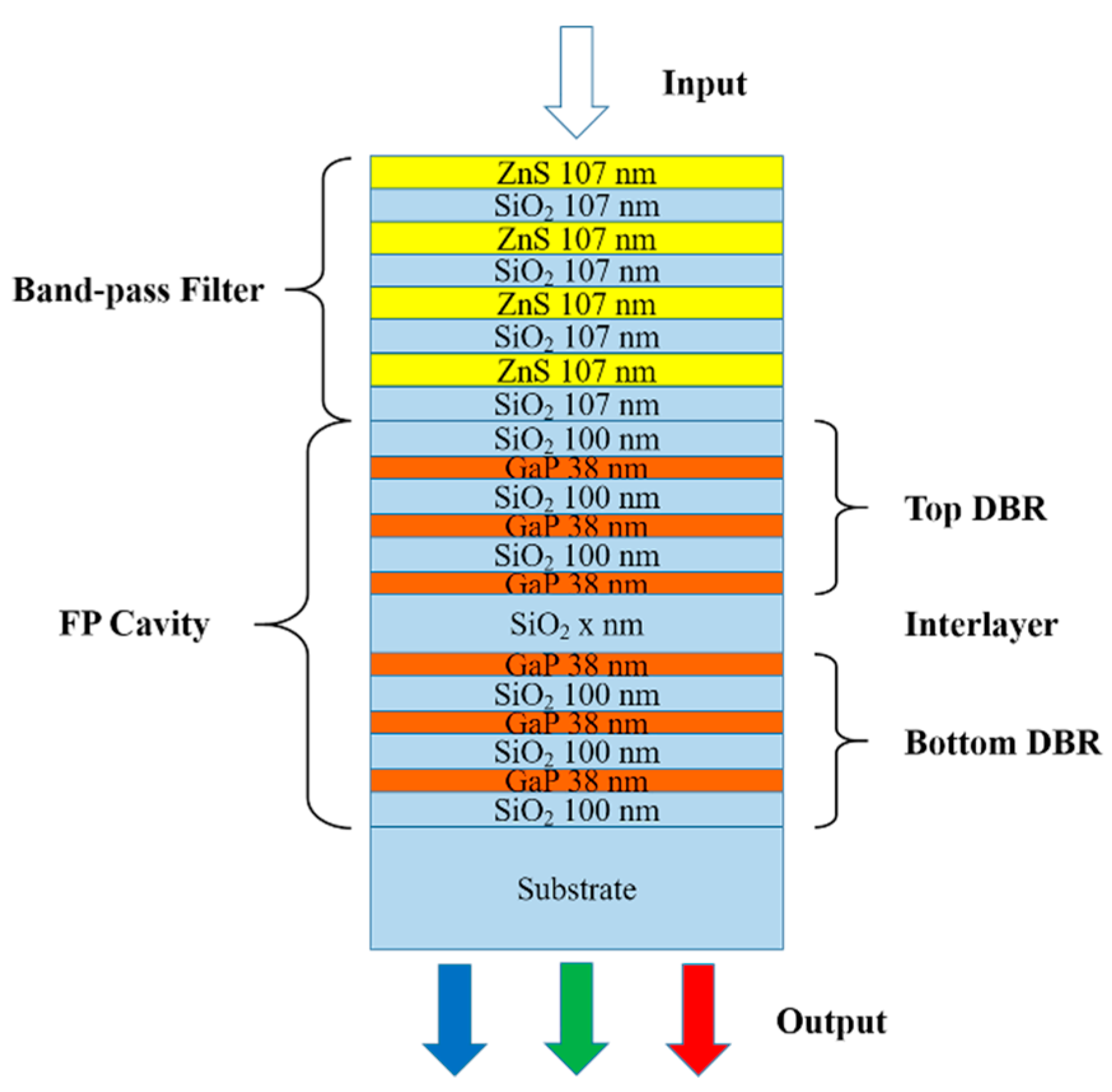

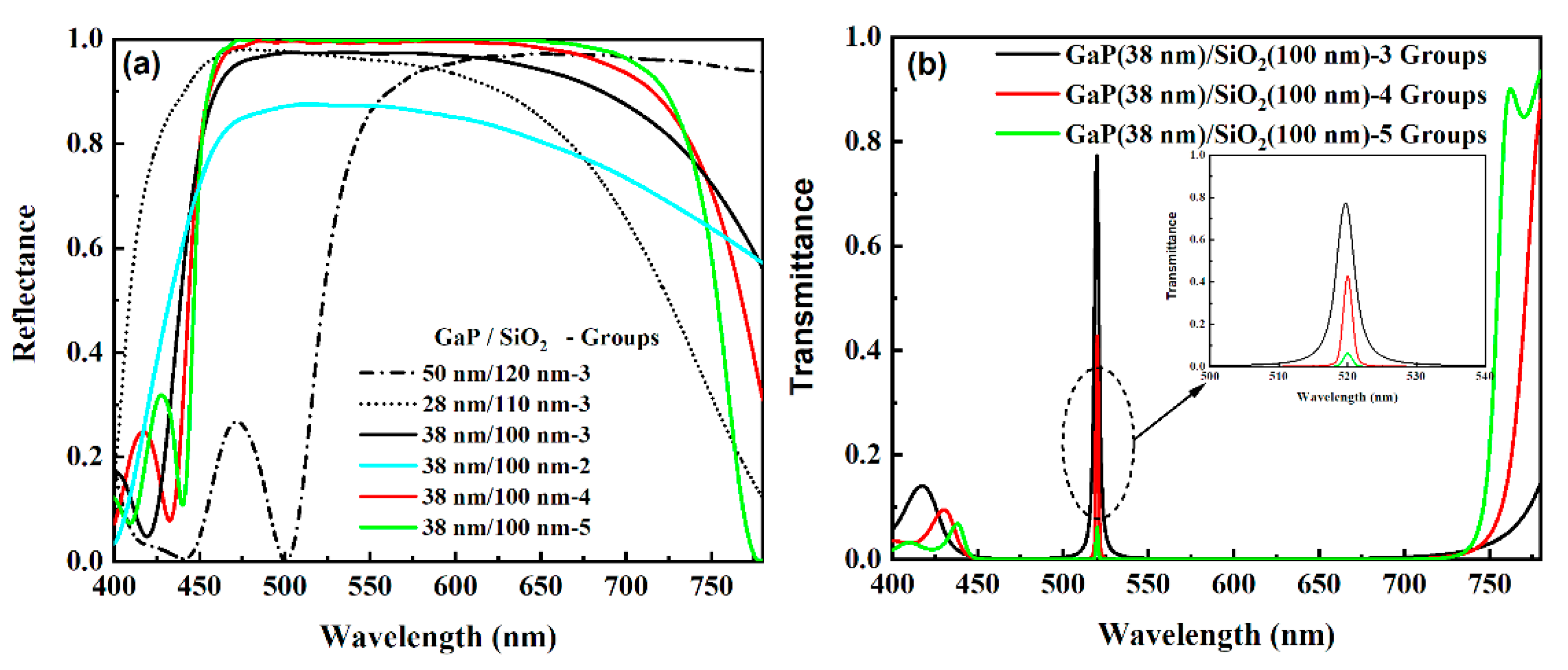
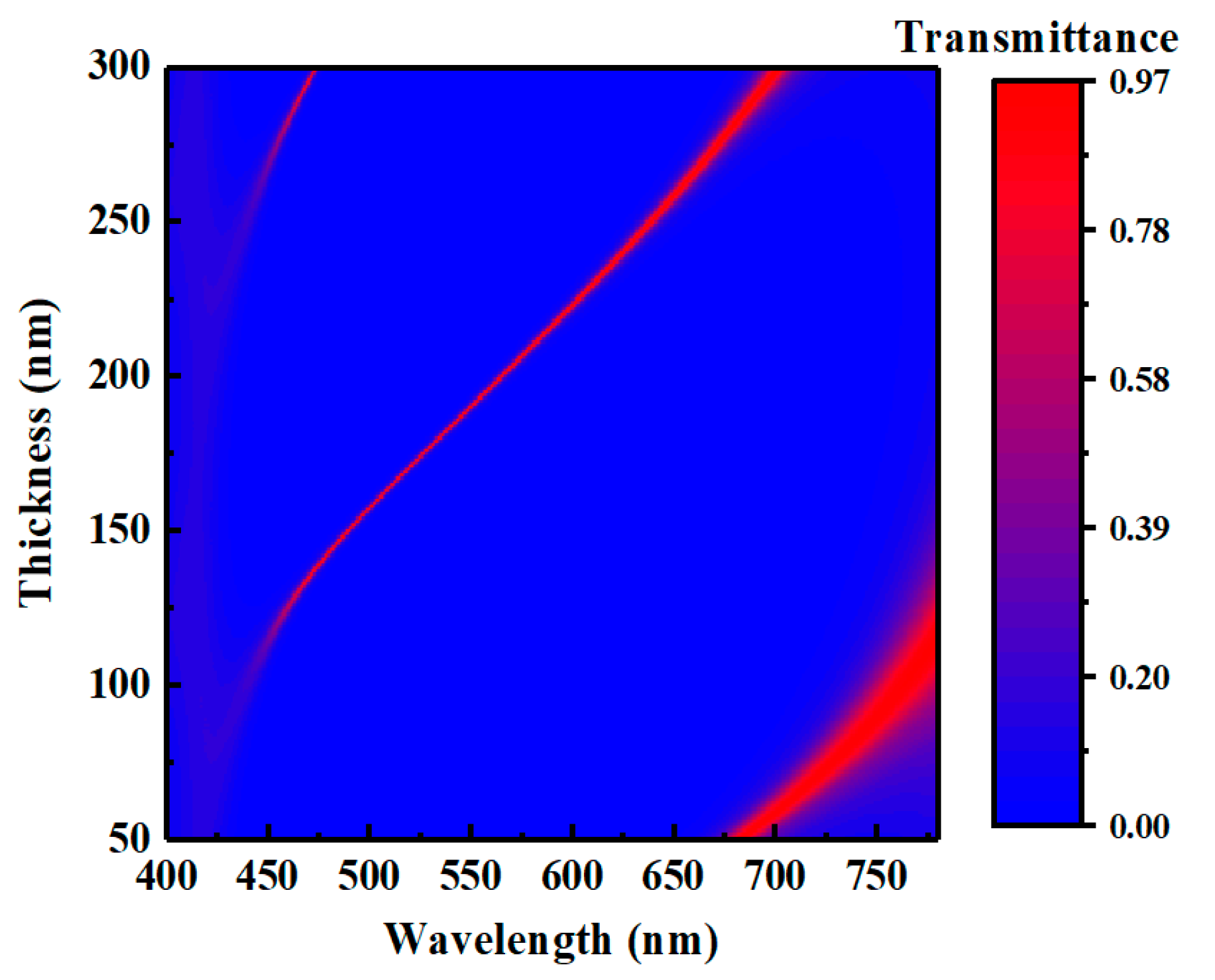

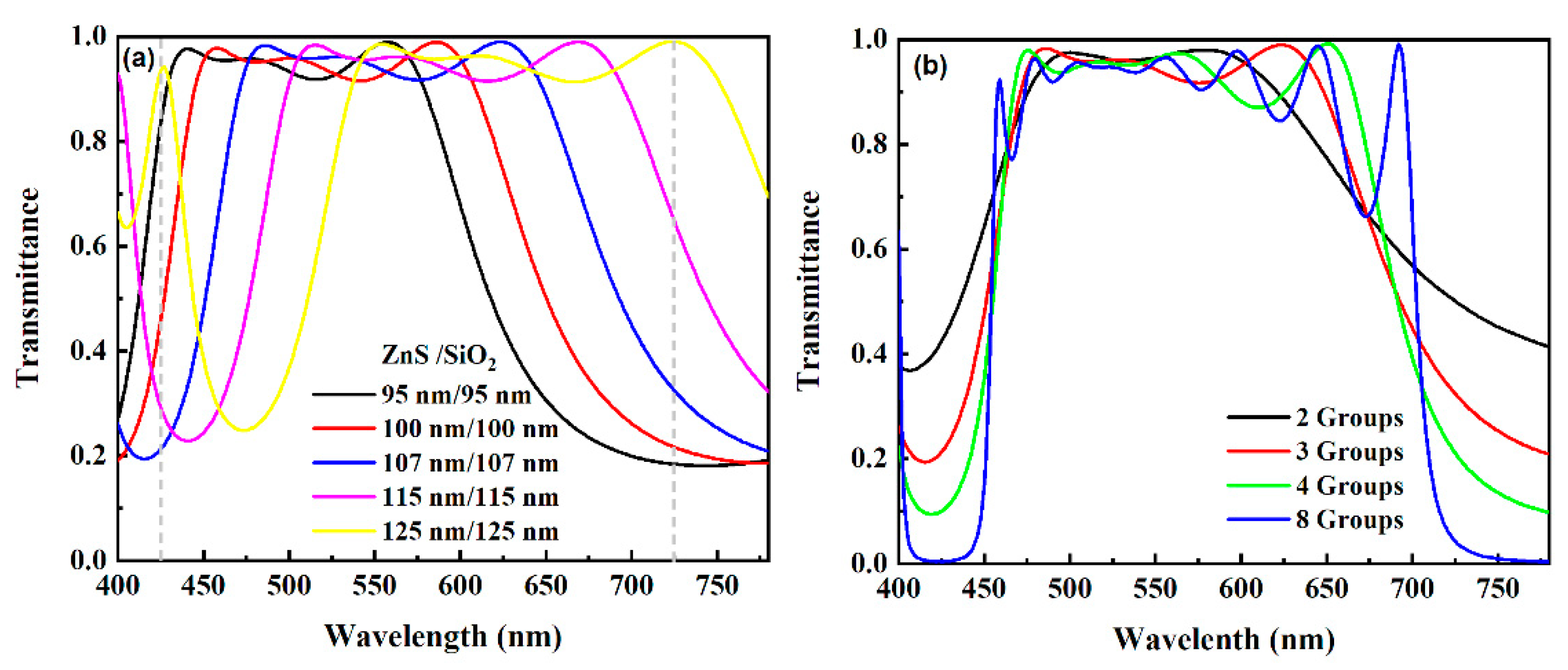

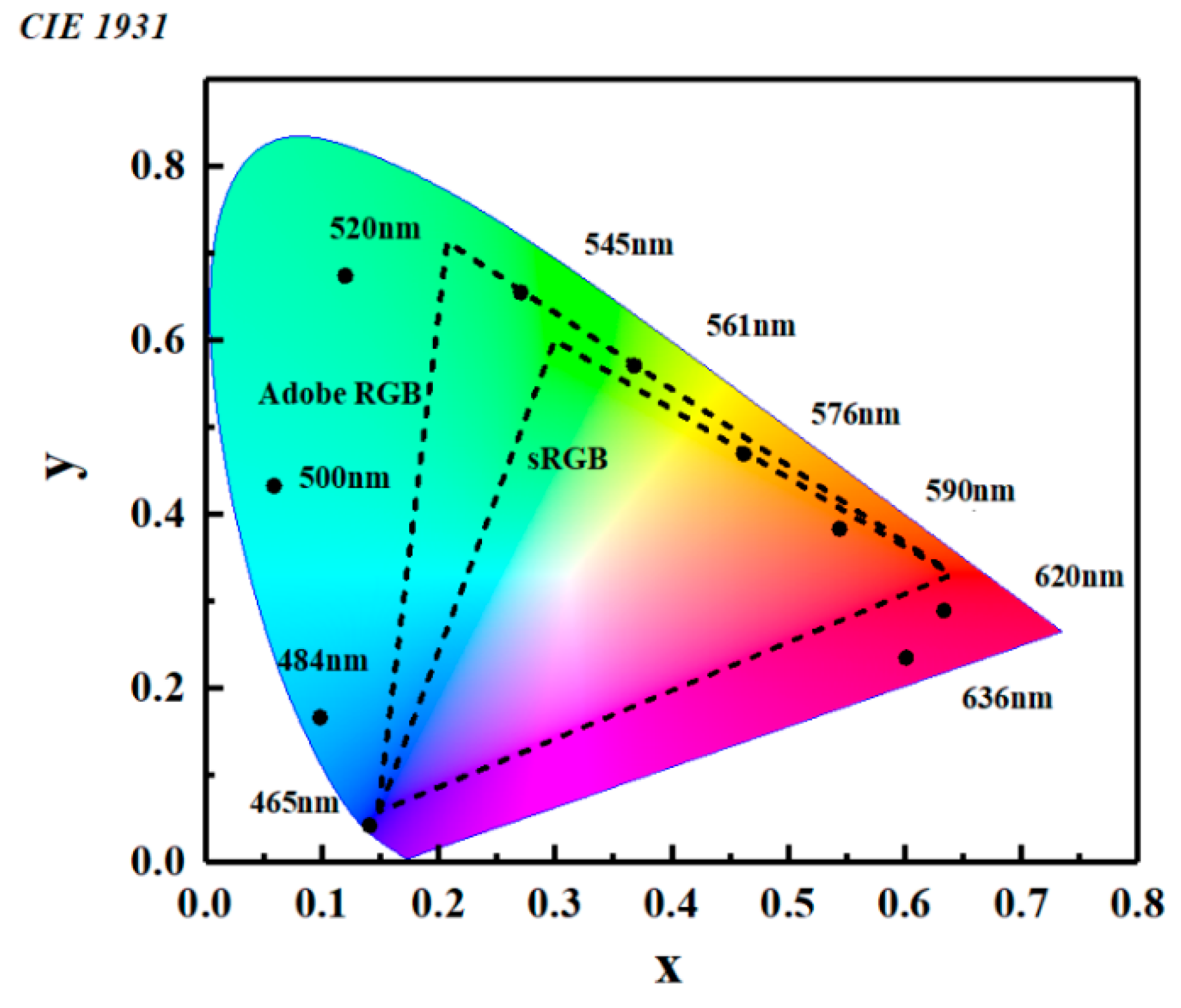

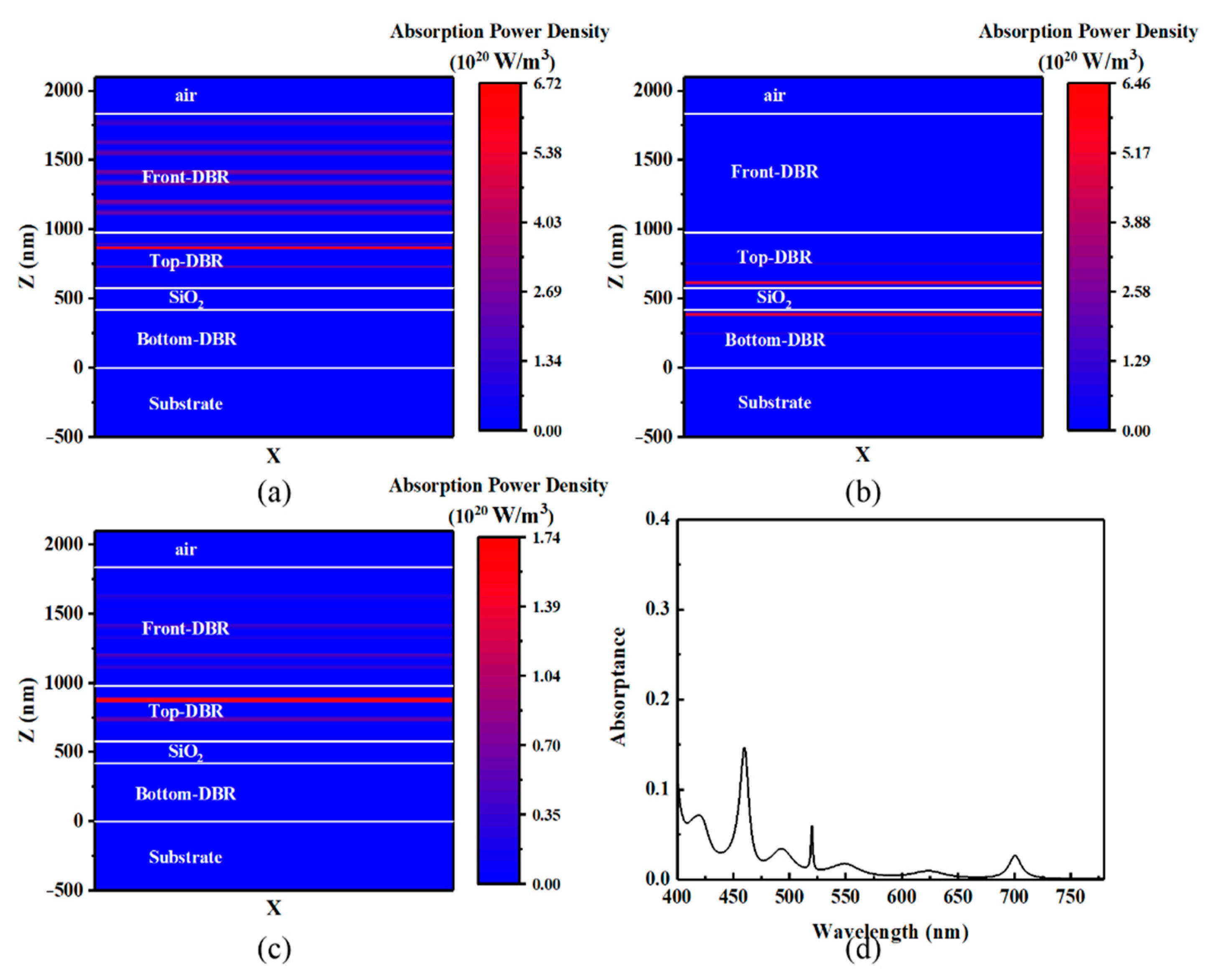
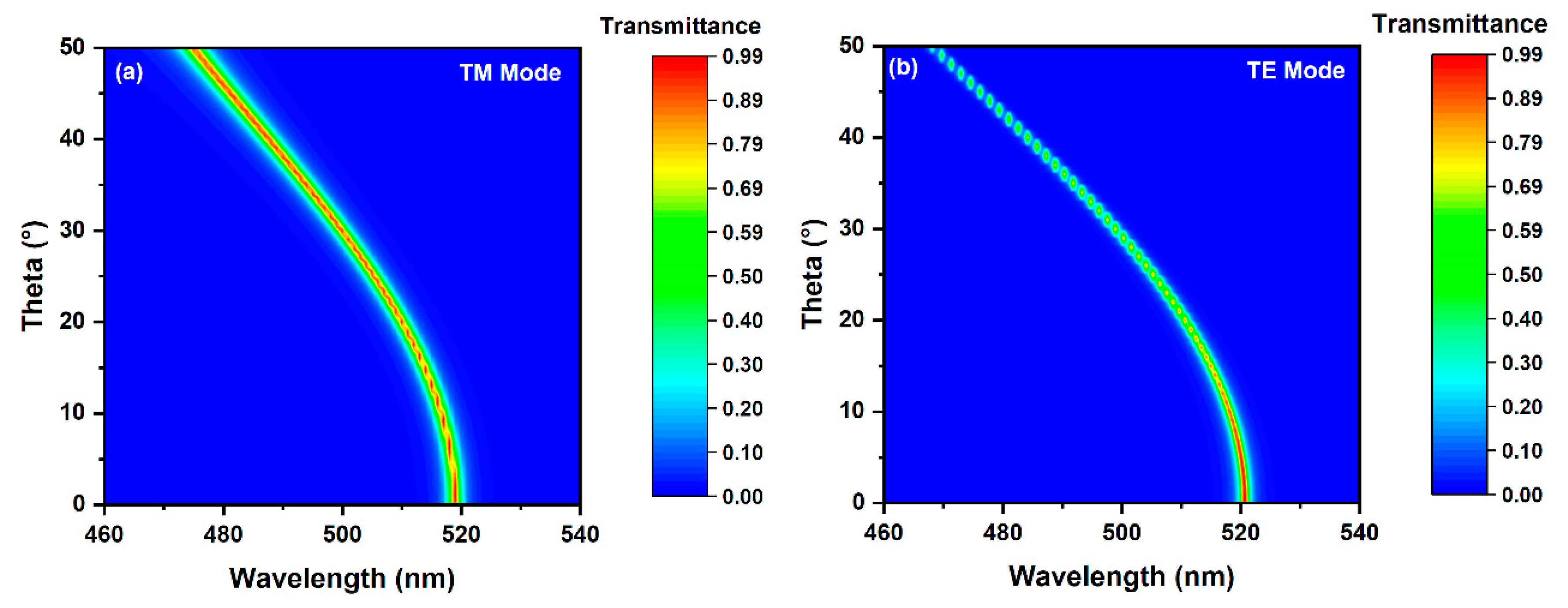
| Thickness of SiO2 (nm) | Center Wavelength (nm) | Maximum Transmittance | FWHM (nm) |
|---|---|---|---|
| 128 | 465 | 0.756 | 6.46 |
| 144 | 484 | 0.833 | 3.11 |
| 156 | 500 | 0.841 | 3.02 |
| 170 | 520 | 0.822 | 2.05 |
| 186 | 545 | 0.889 | 2.97 |
| 196 | 561 | 0.867 | 2.93 |
| 206 | 576 | 0.856 | 2.59 |
| 216 | 590 | 0.847 | 2.82 |
| 234 | 620 | 0.902 | 5.35 |
| 248 | 636 | 0.911 | 6.45 |
Publisher’s Note: MDPI stays neutral with regard to jurisdictional claims in published maps and institutional affiliations. |
© 2021 by the authors. Licensee MDPI, Basel, Switzerland. This article is an open access article distributed under the terms and conditions of the Creative Commons Attribution (CC BY) license (http://creativecommons.org/licenses/by/4.0/).
Share and Cite
Xu, K.; Meng, Y.; Chen, S.; Li, Y.; Wu, Z.; Jin, S. All-Dielectric Color Filter with Ultra-Narrowed Linewidth. Micromachines 2021, 12, 241. https://doi.org/10.3390/mi12030241
Xu K, Meng Y, Chen S, Li Y, Wu Z, Jin S. All-Dielectric Color Filter with Ultra-Narrowed Linewidth. Micromachines. 2021; 12(3):241. https://doi.org/10.3390/mi12030241
Chicago/Turabian StyleXu, Kai, Yanlong Meng, Shufen Chen, Yi Li, Zhijun Wu, and Shangzhong Jin. 2021. "All-Dielectric Color Filter with Ultra-Narrowed Linewidth" Micromachines 12, no. 3: 241. https://doi.org/10.3390/mi12030241
APA StyleXu, K., Meng, Y., Chen, S., Li, Y., Wu, Z., & Jin, S. (2021). All-Dielectric Color Filter with Ultra-Narrowed Linewidth. Micromachines, 12(3), 241. https://doi.org/10.3390/mi12030241







